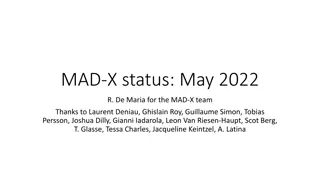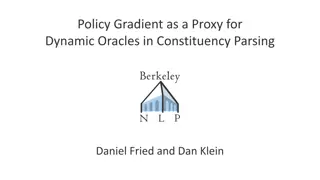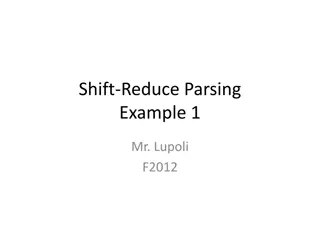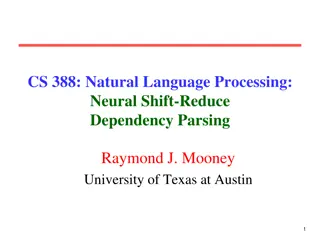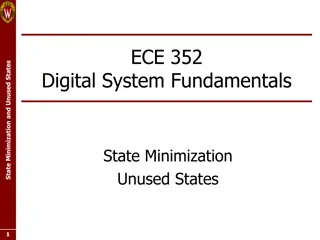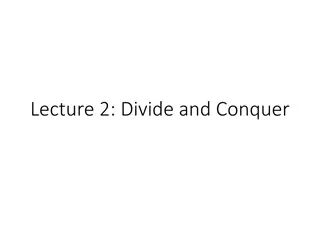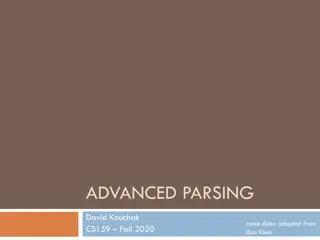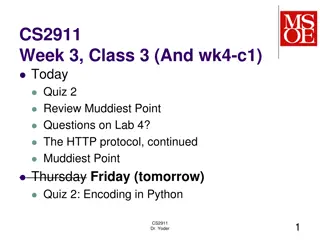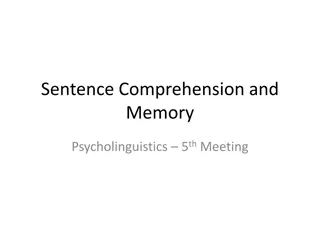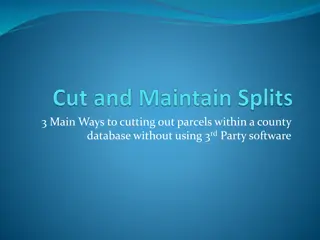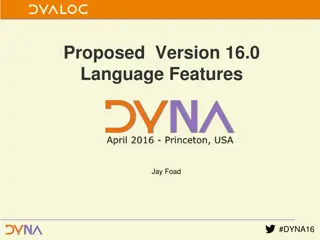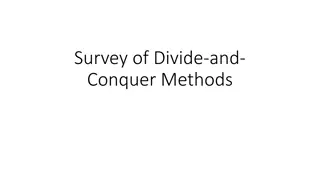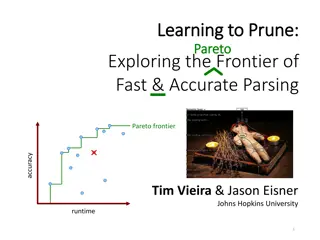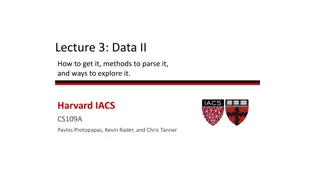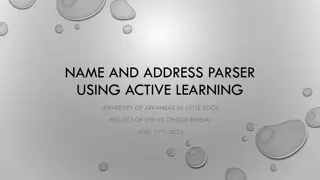Understanding LR Parsing and State Merging Techniques
The content discusses LR parsing techniques such as LR(0), SLR(1), LR(1), LALR(1), and their advantages in resolving shift-reduce and reduce-reduce conflicts. It also delves into state merging in LR parsing, highlighting how merging states can introduce conflicts and affect error detection in parsers.
Download Presentation

Please find below an Image/Link to download the presentation.
The content on the website is provided AS IS for your information and personal use only. It may not be sold, licensed, or shared on other websites without obtaining consent from the author. Download presentation by click this link. If you encounter any issues during the download, it is possible that the publisher has removed the file from their server.
E N D
Presentation Transcript
Compilation Principle 11 (8) xianweiz.github.io DCS290, 4/6/2021
Review Questions (1) Why LR(0) is of limited usage? No lookahead, easy to have shift-reduce and reduce-reduce conflicts How does SLR(1) improve LR(0)? Lookahead using the Follow set when reduce happens Why we further use LR(1)? Follow set is not precise enough, still easy to have conflicts At high level, how does LR(1) improve SLR(1)? Splitting Follow set (i.e., splitting states) to enforce reduce to consider not only the stack top How does LR(1) split the states? Add lookaheads to each item, i.e., LR(1) item=LR(0) item+lookahead 2
Review Questions (2) How to understand the item [A -> u , a/b/c] Reduce only using A -> u, when the next input symbol is a/b/c Then, what are the drawbacks of LR(1)? More states because of the splitting, further much larger parse table What is LALR(1)? LookAhead LR. A compromise between LR(1) and LR(0)/SLR(1) How does LALR(1) improve LR(1)? Merge similar states to reduce table rows LR(0) -> SLR(1) -> LR(1), what is trend of improvement? Reduce action is more and more precise 3
State Merging[] Merge states with the same core[ ] Core: LR(1) items minus the lookahead (i.e., LR(0) items) All items are identical except lookahead I3: X a X, a/b X .aX, a/b X b, a/b I6: X a X, $ X .aX, $ X b, $ I36: X a X, a/b/$ X .aX, a/b/$ X b, a/b/$ I4: X b , a/b I7: X b , $ I47: X b , a/b/$ I8: X aX , a/b I9: X aX , $ I89: X aX , a/b/$ 4
State Merging (cont.) ACTION GOTO ACTION GOTO State State a b $ S X a b $ S X 0 s3 s4 1 2 0 s36 s47 1 2 1 acc 1 acc 2 s6 s7 5 2 s36 s47 5 3 s3 s4 8 36 s36 s47 89 4 r3 r3 47 r3 r3 r3 5 r1 5 r1 6 s6 s7 9 89 r2 r2 r2 7 r3 LALR(1) 8 r2 r2 9 r2 LR(1) 5
Merge Effects Merging of states can introduce conflicts[ ] Cannot introduce shift-reduce (s-r) conflicts i.e., a s-r conflict cannot exist in a merged set unless the conflict was already present in one of the original LR(1) sets Can introduce reduce-reduce (r-r) conflicts LR was introduced to split the Follow set on reduce action Merging reverts the splitting Detection of errors may be delayed[ ] On error, LALR parsers will not perform shifts beyond an LR parser, but may perform more reductions before finding error We ll see an example 6
Merge Conflict: Shift-Reduce Shift-reduce conflicts are not introduced by merging Suppose Sij: [A -> , a] reduce on input a [B -> .a?, b] shift on input a Formed by merging Si and Sj Cores must be the same for Si and Sj, and thus one of them must contain [A -> , a] and [B -> .a?, b] Shift-reduce conflicts were already present in either Si and Sj (or both) and not newly introduced by merging 7
Merge Conflict: Reduce-Reduce Reduce-reduce conflicts can be introduced by merging S' > S S > aBc | bCc | aCd | bBd B > e C > e I69: C e , c/d B e , d/c Reduce to B or C when next token is c or d 8
Example: Error Delay S0 $ S0S3 $ a S0S3S3 $ a a S0S3S3S4 $ a a b (0) S -> S (1) S -> XX (2) X -> aX (3) X -> b state symbol aab$ Input: aab$ state symbol ab$ ACTION GOTO State state symbol a b $ S X b$ 0 s3 s4 1 2 state symbol 1 acc $ 2 s6 s7 5 3 s3 s4 8 4 r3 r3 5 r1 6 s6 s7 9 7 r3 8 r2 r2 9 9 r2
Example: Error Delay (cont.) S0 $ S0S36 $ a S0S36S36 $ a a S0S36S36S47 $ a a b S0S36S36S89 $ a a X S0S36S89 $ a X S0S2 $ X (0) S -> S (1) S -> XX (2) X -> aX (3) X -> b state symbol aab$ Input: aab$ state symbol ab$ ACTION GOTO State state symbol a b $ S X b$ 0 s36 s47 1 2 state symbol 1 acc $ 2 s36 s47 5 state symbol 36 s36 s47 89 $ 47 r3 r3 r3 state symbol 5 r1 $ 89 r2 r2 r2 state symbol $ 10
LALR Table Construction[] LALR(1) parsing table is built from the configuration sets in the same way as LR(1)[ ] The lookaheads determine where to place reduce actions If there are no mergable states, the LALR(1) table will be identical to the LR(1) table and we gain nothing Usually, there will be states that can be merged and the LALR table will thus have fewer rows than LR LALR(1) table have the same #states (rows) with SLR(1) and LR(0), but have fewer reduce actions[ ] Some reductions are not valid if we are more precise about the lookahead Some conflicts in SLR(1) and LR(0) are avoided by LALR(1) 11
LALR Table Construction (cont.) Brute force[ ] Construct LR(1) states, then merge states with same core If no conflicts, you have a LALR parser Inefficient: building LR(1) items are expensive in time and space We need a better solution Efficient way[ ] Avoid initial construction of LR(1) states Merge states on-the-fly (step-by-step merging) States are created as in LR(1) On state creation, immediately merge if there is an opportunity 12
LALR(1) Grammars For a grammar, if the LALR(1) parse table has no conflicts, then we say the grammar is LALR(1) No formal definition of a set of rules LALR(1) is a subset of LR(1) and a superset of SLR(1) A SLR(1) grammar is definitely LALR(1) A LR(1) grammar may or may not be LALR(1) Depends on whether merging introduces conflicts A non-SLR(1) grammar may be LALR(1) Depends on whether the more precise lookaheads resolve the SLR(1) conflicts LALR(1) reaches a good balance between the lookahead power and the table size Most used variant of the LR family 13
LL vs. LR Parsing (LL < LR) LL(k) parser, each expansion A -> is decided based on Current non-terminal at the top of the stack Which LHS to produce k terminals of lookahead at beginning of RHS Must guess which RHS by peeking at first few terminals of RHS LR(k) parser, each production A -> is decided based on RHS at the top of the stack Can postpone choice of RHS until entire RHS is seen Common left factor is OK waits until entire RHS is seen anyway Left recursion is OK does not impede forming RHS for reduction k terminals of lookahead beyond RHS Can decide on RHS after looking at entire RHS plus lookahead 14
: 1 (Syntax analysis) : token : (parse tree) (abstract syntax tree ,AST) (Syntax specification) RE/FA (e.g., ) (grammar), (context- free grammar, CFG) : {T, N, s, ?} T: terminal symbols[ ] = token, N: non-terminal symbols[ ], s: start symbol[ ] ?: set of productions[ ], LHS -> RHS 16
: 2 (Derivation) ( LHS RHS) (input string) (Reduce) ( RHS LHS) (input string) (Parse tree) (Ambiguous grammar) ( ) (precedence) (associativity) 17
: 3 ( ) (Top-down): (Bottom-up): token 18
: 4 Top-down (Recursive descent): -> (backtracking) (Left recursion) (Predictive): (Left factoring) LL(1) input buffer, stack, parse table, parser driver <stack top, current token> (expand or match) $ First Follow 19
: 5 Bottom-up (Shift) (Reduce) LR LR input buffer, stack, parse table, parser driver (shift or reduce) Action Goto (i.e., DFA) LR(0) -> SLR(1) -> LR(1) -> LALR(1) 20
Compilation Principle 11 (1) xianweiz.github.io DCS290, 4/6/2021
Compilation Phases[] Source Code Lexical Analysis Token Stream Front End Analysis Syntax Analysis Syntax Tree Semantic Analysis Syntax Tree Intermediate Code Generation IR Back End Synthesis Optimization IR Code Generation Target Code 22
Compilation Phases (cont.) Lexical analysis[ ] Source code tokens Detects inputs with illegal tokens Is the input program lexically well-formed? Syntax analysis[ ] Tokens parse tree or abstract syntax tree (AST) Detects inputs with incorrect structure Is the input program syntactically well-formed? Semantic analysis[ ] AST (modified) AST + symbol table Detects semantic errors (errors in meaning) Does the input program has a well-defined meaning? 23
Example base class not defined wrong type 1) y variable not declared 2) cannot multiple a string cannot redefine functions cannot add void to int no main() function 24
Why Semantic Analysis?[] Because programs use symbols (a.k.a. identifiers) Identifiers require context to figure out the meaning Consider the English sentence: He ate it This sentence is syntactically correct But it makes sense only in the context of a previous sentence: Sam bought a pizza. Semantic analysis Associates identifiers with objects they refer to[ ] He --> Sam it --> pizza Checks whether identifiers are used correctly[ ] He and it refer to some object: def-use check it is a type of object that can be eaten: type check 25
Why Semantic Analysis (cont.) Semantics of a language is much more difficult to describe than syntax[ ] Syntax: describes the proper form of the programs Semantics: defines what the programs means (i.e., what each program does when it executes) Context cannot be analyzed using a CFG parser[CFG ] Associating IDs to objects require expressing the pattern: {wcw | w (a|b)*} The first w represents the definition of a ID The c represents arbitrary intervening code The second w represents the use of the ID 26
Semantic Analysis Deeper check into the source program[ ] Last stage of the front end Compiler s last chance to reject incorrect programs Verify properties that aren t caught in earlier phases Variables are declared before they re used[ ] Type consistency when using IDs[ ] Expressions have the right types[ ] Gather useful info about program for later phases[ ] Determine what variables are meant by each identifier Build an internal representation of inheritance hierarchies Count how many variables are in scope at each point 27
Semantic Analysis: Implementation Attribute grammars[ ] One-pass compilation Semantic analysis is done right in the middle of parsing Augment rules to do checking during parsing Approach suggested in the Compilers book AST walk[ ] Two-pass compilation First pass digests the syntax and builds a parse tree The second pass traverses the tree to verify that the program respects all semantic rules Strict phase separation of Syntax Analysis and Semantic Analysis 28
Syntax Directed Translation[] Source Code Lexical Analysis Token Stream Syntax Analysis Syntax Tree Semantic Analysis Syntax Directed Translation ( ) Syntax Tree Semantic Translation ( ) Intermediate Code Generation IR Optimization IR Code Generation Target Code 29



